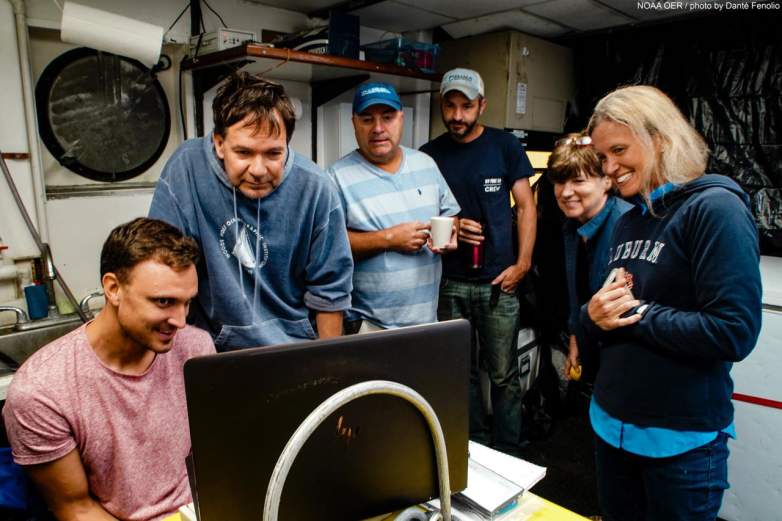
Scientists Dr. Edie Widder, Dr. Sönke Johnsen, and Dr. Nathan Robinson plunged to the depths of the ocean to discover a rare species in its natural habitat, a giant squid in one of the darkest sections of the ocean.
Widder, Johnsen, Robinson their crew made their way into the ocean just 100 miles off the coast of Alabama and Louisiana via their special red light camera, according to CNN. Their journey led to one of the most historic discoveries in United States ocean exploration history – a giant squid right here in US waters. Scientists estimate the squid to be up to 12 feet long.
“We knew immediately that it was a squid. It was also big, but because it was coming straight at the camera, it was impossible to tell exactly how big. But big – at least 3 to 3.7 meters (10 to 12 feet) long,” Johnsen and Widder wrote on the NOAA’s Ocean Exploration and Research website. “Most importantly, we did not find a monster. The giant squid is large and certainly unusual from our human perspective, but if the video shows anything of the animal’s character, it shows an animal surprised by its mistake, backing off after striking at something that at first must have seemed appealing but was obviously not food.”
The footage of the giant squid extending its undulating arms to show off its long tentacles comes at about 2500 feet under the surface of the Gulf of Mexico, per the Washington Post. This is the first time a giant squid in US waters has been caught on video.
You can watch the video below:
The expedition led by Widder, Johnsen and Robinson was funded by the National Oceanic and Atmospheric Administration.
The NOAA said the goal of the mission was to collect samples “on the characterization of visual systems, bioluminescence, and fluorescence of organisms living below 1,000 meters (3,280 feet).” This level of ocean depth is known as the “midnight zone.”
History Made
The camera used to capture the footage was developed by Dr. Widder, who is the founder of the Ocean Research and Conservation Association. Known as the Medusa, the camera uses red light, which goes unnoticed by deep sea creatures, to discover new species and monitor more elusive sea creatures.
As Dr. Robinson, director of Cape Eleuthera Institute in the Bahamas, was observing the footage the Medusa captured, he became more and more excited by what was appearing on the screen.
“I started to see a tentacle and I got more and more excited and then when the tentacles pulled back there aren’t words to describe it,” Robinson told CNN.
Widder was equally excited, as this was her second time seeing a giant squid on camera and the first time in US waters.
“We all proceeded to go slightly nuts,” Widder told CNN. “We know so little about how these animals survive in the depths… this helps us learn something more about how they hunt and their energy budget, but we need to know a lot more.”
The rarity of such an event, capturing a giant squid on camera, is something that hadn’t been done until 2012. Widder and her colleagues used the Medusa off of the coast of Japan to capture first ever footage of the giant squid in its natural habitat, according to the Washington Post.
Seeing Is Believing & Believing Leads to Caring

NOAA/Danté FenolioLeft to right Nathan Robinson, Sonke Johnsen, Tracey Sutton, Captain of the Pt Sur- Nick Allen, Edie Widder and Megan McCall gather around to watch the squid video.
Dr. Sönke Johnsen hopes the footage of the giant squid will help lead to further conservation efforts. Johnsen was the leader of the expedition and is a professor of biology at Duke University.
“It’s easier to see whales and dolphins, but it’s very difficult to get excited about the something covered in thousands of tons of water,” Johnsen told CNN. “At a time in the world when the environment is in crisis people protect what they love, and they love what they see.”
The excitement of discovery does more than just fire up those in the science community, the scientists leading the discovery said. They hope it will inspire thousands to get involved in the science and conservation community.
“Love of nature is a stronger force for conservation than fear of doing the wrong thing,” Johnsen said.